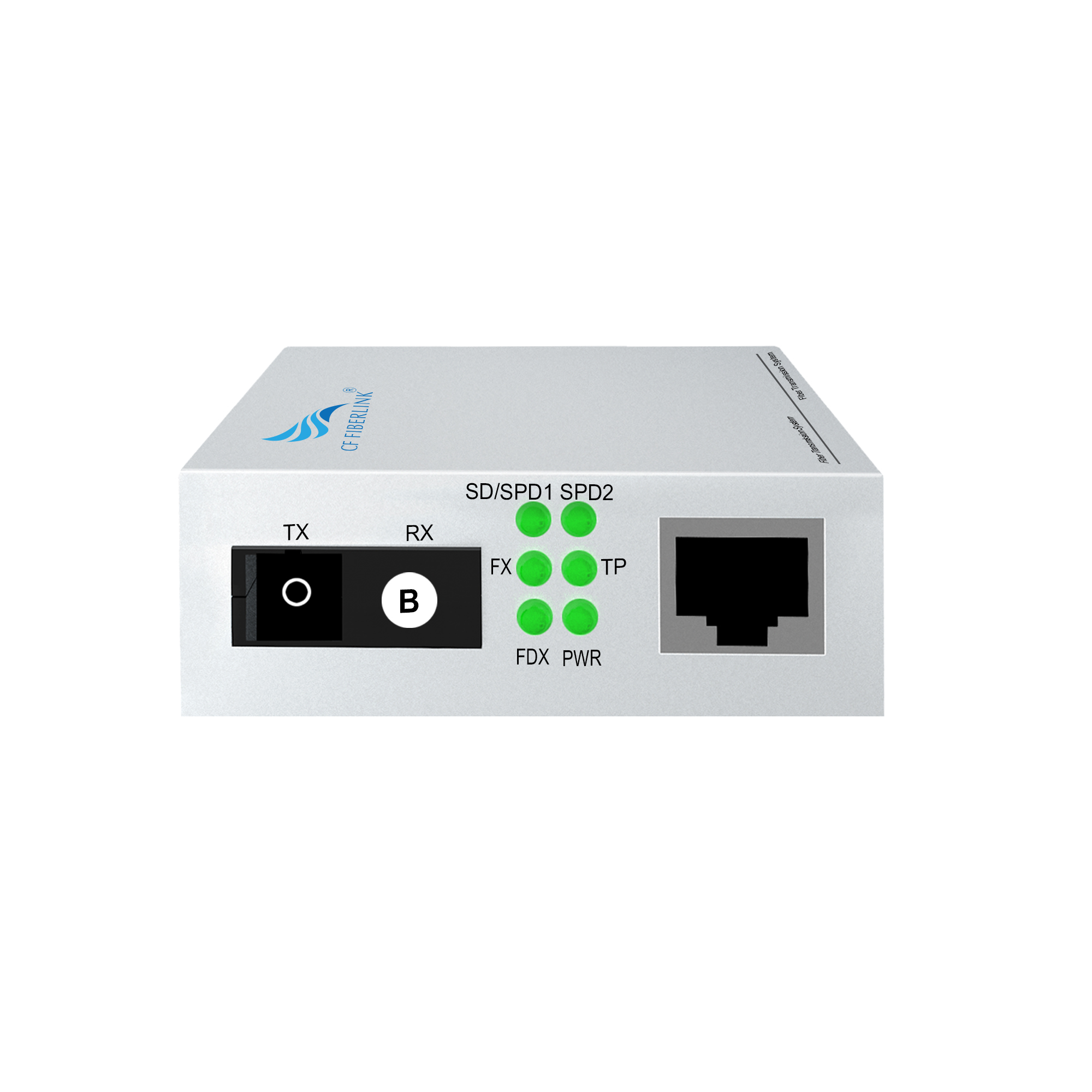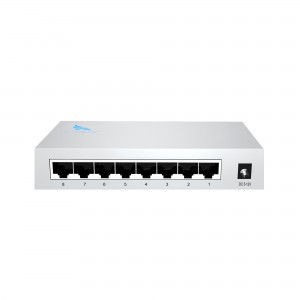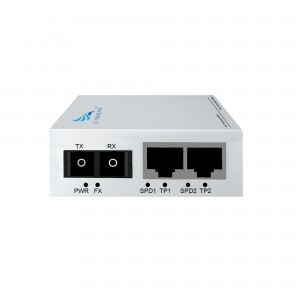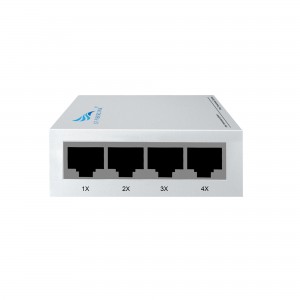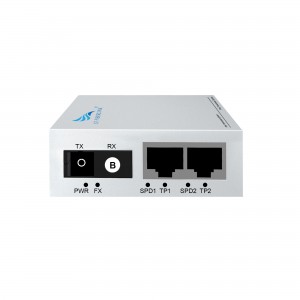2-port 10/100M Media Converter (Single-mode Single-fiber SC)
2-port 10/100M Media Converter (Single-mode Single-fiber SC)
Product Features:
Brief introduction of unmanaged optical fiber converter: 1 optical 1 electrical single-mode single-fiber B terminal
Huizhou Changfei Optoelectronics Technology Co., Ltd. is pleased to present our latest innovation in optical fiber technology – unmanaged optical fiber converter: 1 optical 1 electrical single-mode single-fiber B-end. As a professional manufacturer of industrial smart network managed switches, PoE switches, Ethernet switches, wireless bridges and wireless 4G routers in China, we strive to provide cutting-edge solutions to meet customers’ ever-changing needs.
Unmanaged fiber converters are specifically designed to provide seamless and reliable fiber connections. Whether you need long-distance transmission or secure data transmission, this converter is the perfect solution for your network needs. With its excellent features and robust design, it is suitable for various industrial applications where stable and secure communication is critical.
One of the distinguishing features of our unmanaged fiber converters is their low power consumption. This energy-efficient converter ensures reduced electricity consumption, making it an environmentally friendly choice. Plus, the iron shell design adds durability and ruggedness to withstand challenging environments. Its IP30 rating protects the converter from dust, debris and other potential hazards, ensuring uninterrupted operation even in harsh conditions.
For added convenience, unmanaged fiber converters come with an external power supply. This eliminates the need for complicated wiring setups, allowing for hassle-free installation. With our converters, you can easily extend your network over long distances and provide your devices with excellent connectivity.
Unmanaged fiber converters are designed for versatility, supporting one fiber and one electrical single-mode single-fiber B-end connection. This feature enables you to seamlessly convert optical signals to electrical signals and vice versa, facilitating smooth communication between different network interfaces. Additionally, the converter follows industry standards, ensuring compatibility with a wide variety of devices and network configurations.
Whether you need a reliable network solution for industrial automation, video surveillance, or other applications, unmanaged fiber converters are ideal for you. Its advanced features and superior performance ensure stable data transmission with minimal delay and signal loss. Plus, our converters feature a compact, sleek design that easily integrates into your existing network infrastructure.
In Huizhou Changfei Photoelectric Technology Co., Ltd., we put customer satisfaction first and pursue excellence in product quality and service. Our team of experienced professionals is dedicated to providing comprehensive technical support and guidance to ensure you have a seamless experience with our products.
In conclusion, Unmanaged Fiber Converter: 1 Optical 1 Electrical Single Mode Single Fiber B-End is a state-of-the-art solution for your network needs. The converter has the characteristics of low power consumption, iron shell design, IP30 protection level and external power supply, providing reliable and safe connection for smooth data transmission. Please believe that Huizhou Changfei Photoelectric Technology Co., Ltd. can provide excellent products to meet your network needs.
What This Product Does
◇ CF-101SW-20B is a Hundred megabytes media converter, providing a Hundred megabytes RJ-45 port and a Hundred megabytes SC fiber port, which can convert between electrical and optical signals. How This Product Works
◇ CF-101SW-20B adopts WDM (wavelength division multiplexing) technology, helping send and receive data at a distance of up to 20 km with only a single mode fiber, which saves half of the cable deployment cost for customers. CF-101SW-20B transmits data at 1550 nm wavelength and receives data at 1310 nm wavelength on optical fiber. Therefore, the terminal device used in conjunction with the CF-101SW-20B should send data at a wavelength of 1310 nm and receive data at a wavelength of 1550 nm. CF FIBERLINK another media converter CF-101SW-20A is one of the products that can cooperate with CF-101SW-20B.
Other Features
◇ Besides, this media converter can be used as a standalone device (no rack required) or used with CF FIBERLINK’s CF-2U14 rack for auto MDI/MDI-X in TX port in which duplex mode is automatically negotiated.
technical parameter:
|
Model |
CF-101SW-20B | |
| Interface Characteristics | ||
|
Fixed Port |
1* 10/ 100Base-TX RJ45 port 1* 155M uplink SC fiber port |
|
|
Ethernet Port |
10/ 100Base-TX auto-sensing, full/half duplex MDI/MDI-X self-adaption |
|
|
Twisted Pair Transmission |
10BASE-T: Cat3,4,5 UTP(≤100 meter) 100BASE-T: Cat5e or later UTP(≤100 meter) |
|
| Optical Port | Default optical module is single-mode single-fiber 20km, SC port | |
| Wavelength/Distance | A-end: RX1310nm / RX1550nm 0 ~ 40KM
B-end:RX1550nm/ RX1310nm 0 ~ 40KM |
|
| A-end: RX1490nm / RX1550nm 0 ~ 120KM
B-end:RX1550nm/ RX1490nm 0 ~ 120KM |
||
| Chip Parameter | ||
| Network Protocol | IEEE802.3 10BASE-T, IEEE802.3i 10Base-T,
IEEE802.3u 100Base-TX, IEEE802.3u 100Base-FX, IEEE802.3x |
|
|
Forwarding Mode |
Store and Forward(Full Wire Speed) |
|
|
Switching Capacity |
0.4Gbps |
|
|
Buffer Memory |
0.3Mpps | |
|
MAC |
1K | |
|
LED Indicator |
Fiber | FX(green) |
| rate | SD/SPD1 (green)
SPD2: 10/ 100 (green) |
|
| Data | TP (green) | |
| Single / duplex | FDX (green) | |
| Power | PWR (green) | |
| Power | ||
| Working Voltage |
AC:100-240V |
|
|
Power Consumption |
Standby<1W, Full load<3W |
|
|
Power Supply |
DC:5V/2A industrial power supply |
|
| Lightning protection &Certification | ||
| Lightning protection | Lightning protection: 4KV 8/20us, Protection level: IP30 | |
| Certification | CCC;CE mark, commercial; CE/LVD EN60950;FCC Part 15 Class B; RoHS | |
| Physical Parameter | ||
| Operation TEMP | -20~+55°C;5%~90% RH Non condensing | |
| Storage TEMP |
-40~+85°C;5%~95% RH Non condensing |
|
| Dimension (L*W*H) | 94mm* 71mm*27mm | |
| Installation | Desktop, CF-2U14 slot rack | |
Product Size:
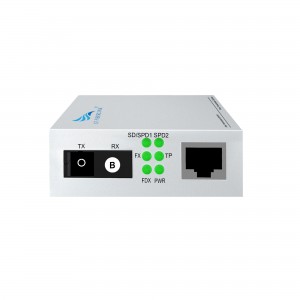
Product application diagra:

How to choose a fiber optic transceiver?
Optical fiber transceivers break the 100-meter limitation of Ethernet cables in data transmission. Relying on high-performance switching chips and large-capacity caches, while truly achieving non-blocking transmission and switching performance, they also provide balanced traffic, isolation and conflict. Error detection and other functions ensure high security and stability during data transmission. Therefore, fiber optic transceiver products will still be an indispensable part of actual network construction for a long time. So, how should we choose fiber optic transceivers?
1. Port function test
Mainly test whether each port can work normally in the duplex state of 10Mbps, 100Mbps and half-duplex state. At the same time, it should be tested whether each port can automatically select the highest transmission speed and automatically match the transmission rate of other devices. This test can be included in other tests.
2. Compatibility test
It mainly tests the connection ability between the optical fiber transceiver and other devices compatible with Ethernet and Fast Ethernet (including network card, HUB, Switch, optical network card, and optical switch). The requirement must be able to support the connection of compatible products.
3. Cable connection characteristics
Test the fiber optic transceiver’s ability to support network cables. First, test the connection ability of Category 5 network cables with lengths of 100m and 10m, and test the connection ability of long Category 5 network cables (120m) of different brands. During the test, the optical port of the transceiver is required to have a connection capability of 10Mbps and a rate of 100Mbps, and the highest must be able to connect to a full-duplex 100Mbps without transmission errors. Category 3 twisted pair cables may not be tested. Subtests can be included in other tests.
4. Transmission characteristics (transmission loss rate of data packets of different lengths, transmission speed)
It mainly tests the packet loss rate when the optical fiber transceiver optical port transmits different data packets, and the connection speed under different connection rates. For the packet loss rate, you can use the test software provided by the network card to test the packet loss rate when the packet size is 64, 512, 1518, 128 (optional) and 1000 (optional) bytes under different connection rates. , the number of packet errors, the number of packets sent and received must be more than 2,000,000. Test transmission speed can use perform3, ping and other software.
5. The compatibility of the whole machine to the transmission network protocol
It mainly tests the compatibility of fiber optic transceivers to network protocols, which can be tested in Novell, Windows and other environments. The following low-level network protocols such as TCP/IP, IPX, NETBIOS, DHCP, etc. must be tested, and the protocols that need to be broadcast must be tested. Optical transceivers are required to support these protocols (VLAN, QOS, COS, etc.).
6. Indicator status test
Test whether the status of the indicator light is consistent with the description of the panel and the user manual, and whether it is consistent with the current status of the fiber optic transceiver.


